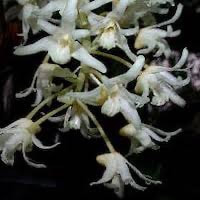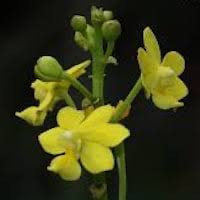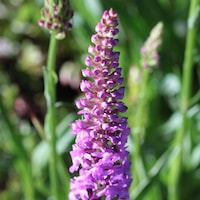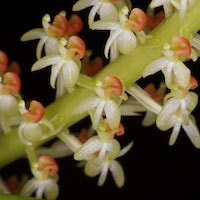MWD1- Men's Woody 1 - Hay! I love you
|
Native Singaporean Orchid notes: Bulbophyllum Laxiflorum
Bulbophyllum laxiflorum is a captivating orchid known for its striking appearance and mild sweet fragrance. It's favored by collectors for its frequent blooming. Native to diverse regions including Thailand, Myanmar, and Indonesia, it thrives in various forests at elevations from 100 to 1800 meters. The orchid's fragrant flowers grow in clusters near leaves and bloom throughout the year. In Traditional Chinese Medicine, it's valued for enhancing Yin, benefiting lung health, aiding digestion, and supporting recovery from injuries. Its traditional uses highlight its cultural and medicinal importance in local communities, ensuring its preservation for future generations.
|
Therapeutic Orchid notes:
|
Eria bractescens Lindl.
Eria bractescens Lindl. is a visually striking orchid known for its oblong pseudobulbs and lanceolate tepals that curve at the tips. It's found across India and Southeast Asia. In the Nicobar Islands, it holds medicinal significance, used traditionally to treat fever, malaria, and body and chest pain. Local communities value its therapeutic properties, integrating it into their healing practices. This traditional use highlights the orchid's role in local culture and underscores the importance of preserving such knowledge for future generations. |
|
Taprobanea spathulata (L.) Christenson. Syn. Vanda spathulata (L.) Spreng
Taprobanea spathulata (formerly Vanda spathulata) is a versatile orchid known in the Indian region as Ponnamponmaraiva in the Malaya-lam dialect, prized for its medicinal uses in traditional healing. It's utilized for treating nerve-related diseases, rheumatism, and even scorpion stings, indicating its analgesic and anti-inflammatory properties. Extracts from the plant are used to balance bile and calm the body, while powdered flowers help with asthma and mental health issues. These practices highlight the orchid's historical role in Indian traditional medicine, preserving valuable botanical knowledge for future generations. |
|
Gymnadenia conopsea (L.) R.Br.
Gymnadenia conopsea, formerly Orchis conopsea, is an orchid species known by multiple names in Chinese and Japanese cultures, including shou shen (hand ginseng) and Tegata-chidori, respectively. It thrives in diverse habitats across Asia and Europe, from open forests to meadows, at elevations of 200 to 4700 meters. In traditional Chinese medicine, it's recognized as Shouzhangshen (Palm ginseng), valued for its kidney benefits, vital essence restoration, and treatment of conditions like coughs and impotence. Scientific studies reveal its tubers' extracts have anti-allergic and lung-protective properties. The orchid's traditional uses underscore its cultural importance, preserving ancient healing wisdom and botanical heritage for future generations. |
|
Liparis condylobulbon Rchb. f. Syn. Liparis treubii J.J. Smith
Liparis condylobulbon, previously known as Liparis treubii and locally called "Anggrek gajang" in Indonesia, is a widespread orchid found from Myanmar to Fiji. In Sulawesi, Indonesia, it holds traditional medicinal value where locals historically used its young pseudobulbs to aid digestion and relieve stomach discomfort. They applied heated leaves to the abdomen for these purposes, showcasing their deep knowledge of local plants. Such practices highlight the orchid's role in traditional healing and cultural heritage, urging preservation of these traditions for future generations. |
Other scent note
Scentopia Library Reference ingredient
Thyme - Check details at Scentopia's scent library
Download the guided mediation that works best with this Orchid fragrance oil
| men_woody_essential_oil_orchi_00001.mp3 | |
| File Size: | 113860 kb |
| File Type: | mp3 |




